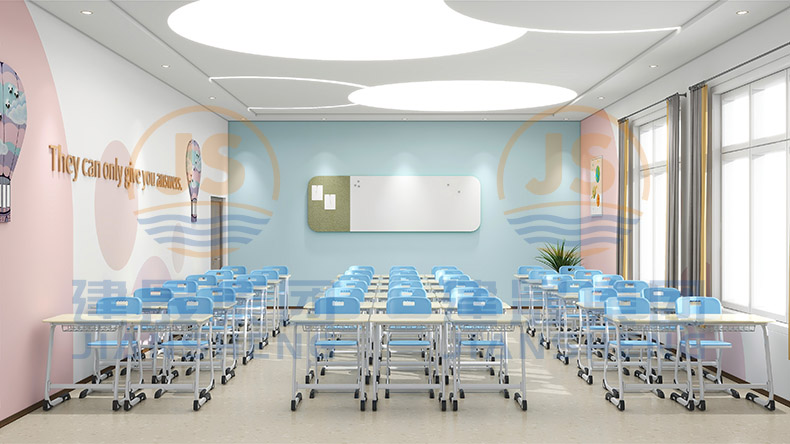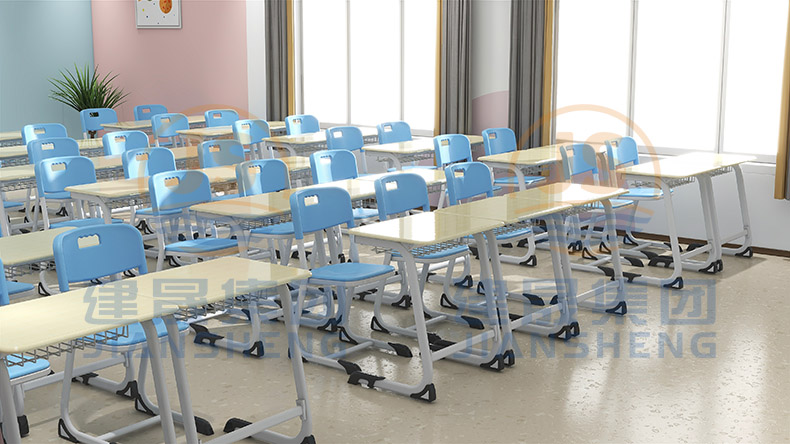- Home
- About Us
- Service
-
Solution
- Kindergarten Classroom
- Primary School Classroom
- Secondary School Classroom
- High School Classroom
- College Classroom
- Training Classroom
- Music Classroom
- Art Classroom
- Lecture Classroom
- Computer Classroom
- Library
- Principal Office
- Administration Office
- Meeting Room
- Reception Room
- Public Area
- Teachers' Office
-
Products
- Case Study
- News
- VR Designs
- Video Center
- JS Lab
- Contact Us

The concept of R&D and manufacturing of school desks and chairs
2024-07-20 22:00
The development and manufacturing of school desks and chairs involves many considerations, aiming to provide an environment that supports learning and health. Let’s discuss the concept of R&D and manufacturing of school desks and chairs and their key factors.
As one of the main tools for students' daily learning and activities, school desks and chairs need to be designed and manufactured not only to meet basic functional needs, but also to take into account students' comfort, safety, health and learning efficiency. This article will explore the core concepts of R&D and manufacturing of school desks and chairs from aspects such as ergonomics, material selection, functional design, and environmental sustainability.

1. Ergonomic design
Ergonomics is the basis for the design of desks and chairs. Its goal is to keep students comfortable and healthy during long-term sitting through reasonable design. This includes the design of the height, angle, and support of seats and tabletops. Seats should have good support and appropriate tilt angles to reduce pressure on students' backs and necks. At the same time, the height of the tabletop should be suitable for students' height so that students can maintain correct posture without causing discomfort or poor posture. In addition, adjustability is also an important design consideration, because students' height and posture may change with age, and desks and chairs should be designed to be able to be flexibly adjusted to accommodate different groups of students.
2. Material selection and safety
Material selection directly affects the safety and durability of desks and chairs. The ideal material should be environmentally friendly, durable and easy to clean. For example, steel and synthetic materials are widely used in manufacturing because they are not only structurally sound but also have a long service life. The safety of materials should also be paid attention to, avoiding the use of harmful substances and ensuring compliance with relevant safety standards and regulations to protect the health and safety of students.
3. Versatility and flexibility
Modern educational environments require desks and chairs to be flexible and multifunctional. Tables and chairs should be designed to accommodate different classroom layouts and learning activity needs. For example, the stackable design can facilitate storage and classroom organization, and the highly mobile tables and chairs can support cooperative learning and group activities in the classroom. In addition, some designs may also integrate power sockets, data interfaces and other facilities to support the use and charging needs of modern technology, which plays an important role in improving learning efficiency and convenience.
4. Environmental protection and sustainability
With today's society paying great attention to environmental protection and sustainable development, the design of school desks and chairs should also take their environmental impact into consideration. Measures such as choosing renewable materials, promoting energy-saving design, and reducing material waste not only help reduce resource consumption, but also help reduce negative impacts on the environment. In addition, designing products with long life and easy recycling is also an important way to achieve sustainable development goals.
5. User participation and feedback
The R&D and manufacturing of school desks and chairs should fully take into account the feedback and needs of users, including students, teachers and managers. Through communication and participation with users, valuable practical experience and suggestions can be obtained, thereby optimizing product design and ensuring that it can achieve better results and greater satisfaction in actual use.

The R&D and manufacturing of school desks and chairs require comprehensive consideration of factors such as ergonomics, material selection, functional design, environmental sustainability and user feedback. Through scientific and reasonable design and manufacturing, we can provide students with a safe, comfortable, fully functional learning environment that meets the needs of modern education, thereby promoting their learning and development. These concepts and practices are not only related to the quality of school facilities, but also to the health of students and the improvement of academic achievements.
Get the latest price? We'll respond as soon as possible(within 12 hours)







